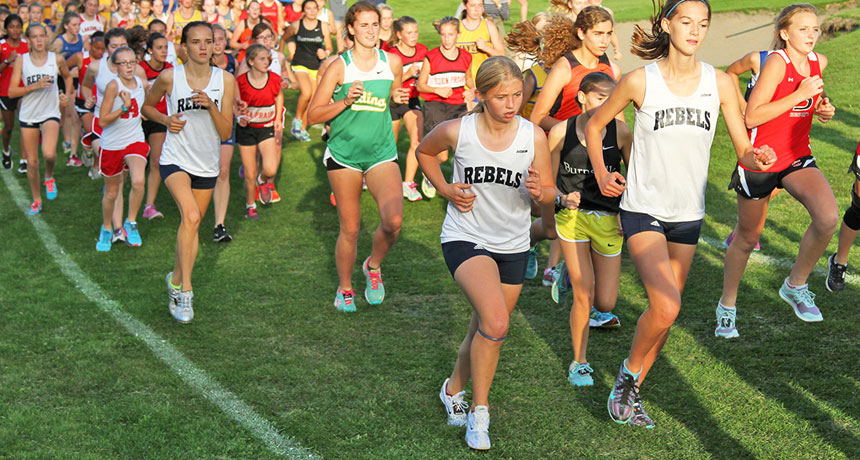Taking science to the track
A teen turned her love of sports into a science project

Audrey Whitman (center, white jersey), loves to exercise. She decided to use her research project to learn more about fitness.
A. Whitman
PHOENIX, Ariz. — Not every science project needs to take place in a fancy laboratory. When Audrey Whitman, 14, started her research, all she needed were the keys to her high school track.
This freshman at Champlin Park High School in Minnesota is a cross-country runner. When it came time for science fair projects, she says, “at first I wasn’t thinking too hard about it.” But when her science teacher encouraged her to study something she liked, she realized she could translate her love of sports into research.
Audrey had learned that someone’s heart rate at rest is associated with cardiovascular fitness — or how efficiently the heart pumps blood. A slower resting heart rate suggests that the heart is pumping blood more efficiently. She wondered if heart rates before and after exercise were associated with how much athletes trained.
“I have this group of friends of mine that run together,” she notes. “It’s kind of our thing.” While Audrey runs cross country, her friends also ski, play soccer, run and play volleyball. This means that they all had different training schedules. The volleyball player only trained six hours a week, while the cross-country skier averaged 11 hours.
Audrey got five of these friends to walk, and then run, once around a track. While they worked, she had them wear a fitness tracker and a heart monitor. She took their heart rate before and after running. Audrey also counted how fast her friends were breathing after walking and running.
Then, the teen took the heart rates and breathing rates, and checked to see if they correlated with how many hours people had trained. A correlation is an apparent link between two variables — or factors in an experiment. If there was a correlation between heart rate and training, for example, it would suggest that people who trained more tended to have lower heart rates. This might mean their hearts were more efficient than those who trained less.
Among her friends, Audrey did find that people who trained more had slower heart rate and breathing rate after running. Athletes who ran the most — including cross country runners and cross-country skiers, who run when there’s no snow — tended to have slower heart rates than those who ran less. The volleyball player had the highest heart rate. But this may not mean she’s out of shape, Audrey explains. It could just mean she doesn’t run as much. “Volleyball players have short spurts of energy,” she notes. “They are jumping up and down. They’re powerhouses.”
Audrey presented her results this week, at the Intel International Science and Engineering Fair. This year’s competition — created by Society for Science & the Public and sponsored by Intel — brought more than 1,600 students from more than 70 countries here to share their scientific projects. (The Society also publishes Science News for Students and this blog.)
Of course, so far the teen only has five people in her study. She wants to study more girls in the future, she says. Audrey would prefer to study female athletes because, well, she is one. She also wants to explore whether the effect seen in runners also shows up in other sports, such as swimming. She even wants to look at different types of exercise. But for that, she needs more people. And that’s okay; she’s still got three more years to get her fellow athletes out to the track.
Follow Eureka! Lab on Twitter
Power Words
(for more about Power Words, click here)
cardiovascular An adjective that refers to things that affect or are part of the heart and the system of vessels and arteries that move blood through the heart and tissues of the body.
correlation A mutual relationship or connection between two variables. When there is a positive correlation, an increase in one variable is associated with an increase in the other. (For instance, scientists might correlate an increase in time spent watching TV with an increase in risk of obesity.) Where there is an inverse correlation, an increase in one value is associated with a decrease in the other. (Scientists might correlate an increase in TV watching with a decrease in time spent exercising each week.) A correlation between two variables does not necessarily mean one is causing the other.
variable (in mathematics) A letter used in a mathematical expression that may take on different values. (in experiments) A factor that can be changed, especially one allowed to change in a scientific experiment. For instance, when researchers measure how much insecticide it might take to kill a fly, they might change the dose or the age at which the insect is exposed. Both the dose and age would be variables in this experiment.